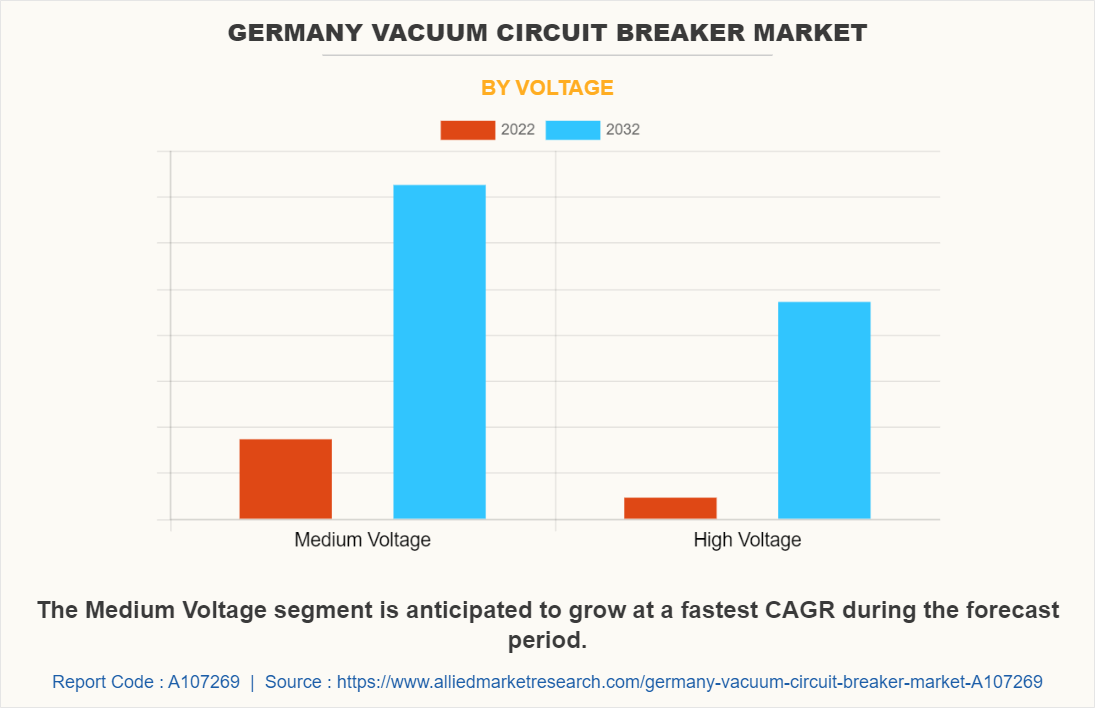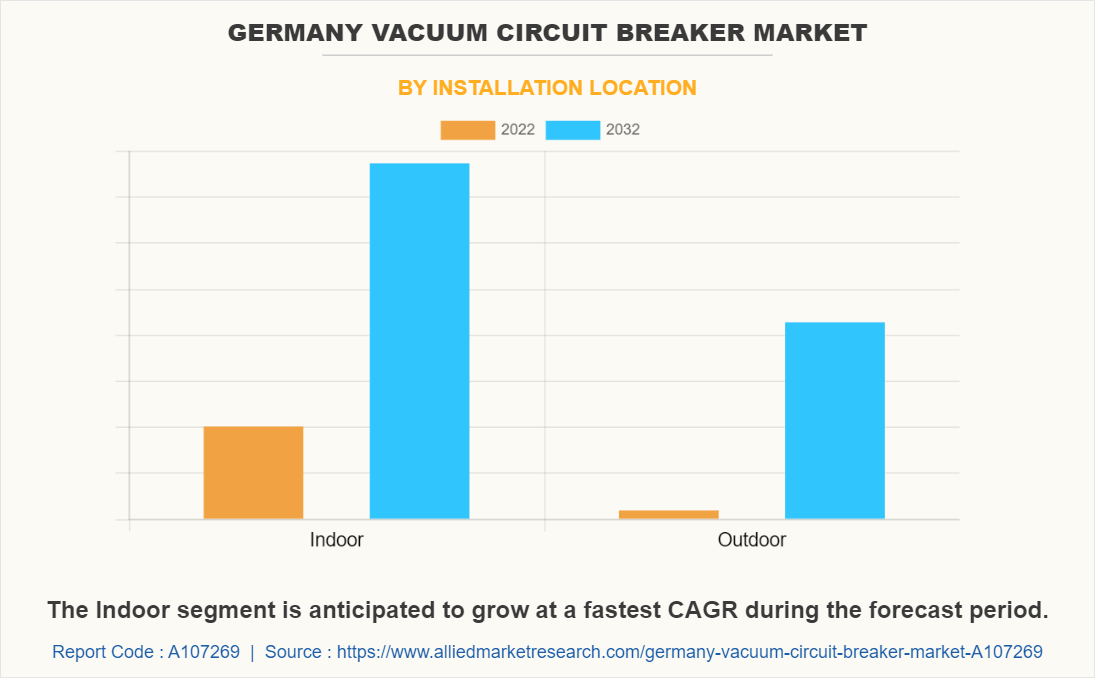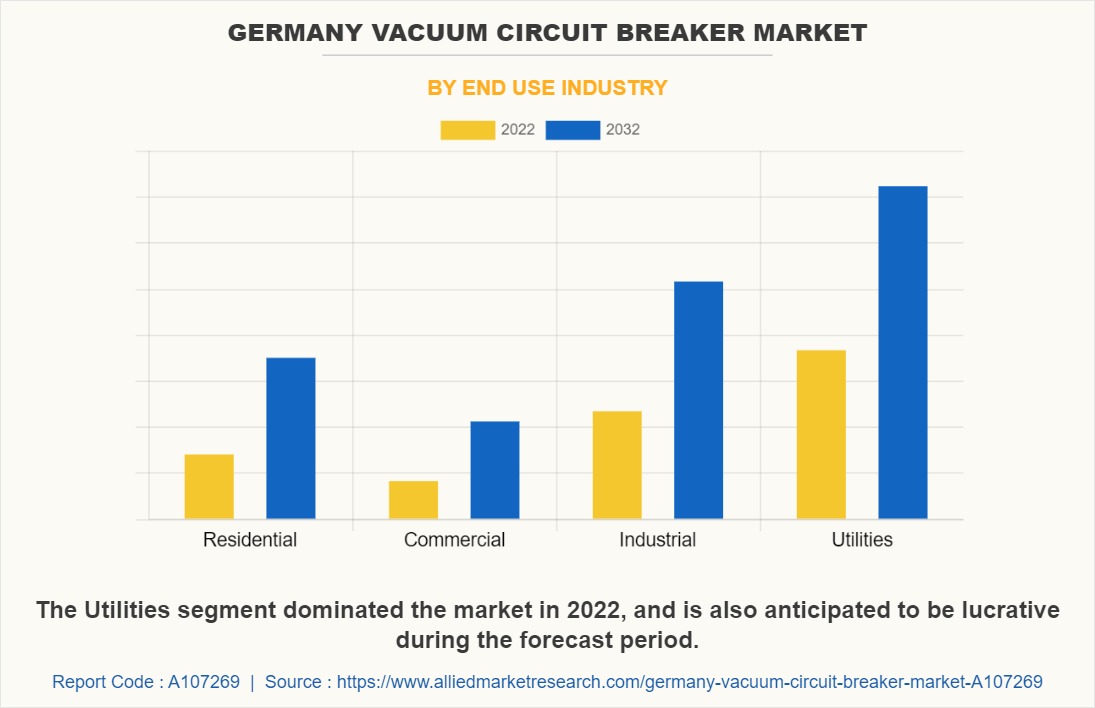The Germany vacuum circuit breaker market is experiencing significant growth during the forecast period. Primarily, the market is driven by the country’s dedication to sustainable and efficient energy solutions. The demand for dependable circuit breakers that handle high-voltage applications has increased due to a rise in focus on renewable energy sources and environmental concerns. In addition, the integration of smart grid technologies and the emphasis on grid modernization have led to the adoption of vacuum circuit breakers, which provide exceptional performance and reliability in high-voltage applications. Furthermore, the German industrial sector, renowned for its strong manufacturing and production capacities, has greatly enhanced the market's need. With the increasing complexity and energy consumption of industrial operations, there is a greater dependence on vacuum circuit breakers to guarantee the stability and security of electrical systems.

On the other hand, the Germany vacuum circuit breaker market encounters certain limitations. A significant obstacle is the high initial expense linked to vacuum circuit breakers. Despite the fact that these breakers provide long-term cost benefits by decreasing maintenance and operational costs, their upfront price discourages potential buyers, particularly in the residential sector. Furthermore, the market is characterized by intense competition, as numerous established and emerging players compete for a portion of the market. This competition results in price wars and reduced profit margins for manufacturers, which hinders market expansion. However, the market offers a plethora of opportunities for both established companies and new entrants. These opportunities are closely linked to the evolving landscape of the electrical industry. With the country's ongoing shift toward renewable energy sources, there is a rise in demand for advanced circuit breakers that guarantee the stability and dependability of the electrical grid. This transition presents a significant opening for manufacturers of vacuum circuit breakers to take advantage of the growing need for efficient and reliable electrical infrastructure.


Depending on the installation location, the market is bifurcated into indoor and outdoor. The determination of the installation site, whether it be indoors or outdoors, is frequently influenced by particular necessities and safety precautions. Residential and commercial settings typically feature indoor installations, whereas outdoor installations are indispensable for utility and industrial purposes, where exposure to environmental factors is a persistent issue. By end-use industry, the market is classified into residential, commercial, industrial, and utilities. The residential sector is in need of compact and cost-effective vacuum circuit breakers that provide protection for homes and families. Commercial establishments, including offices and retail spaces, require dependable electrical systems to ensure seamless operations. The industrial sector has a demand for high-performance circuit breakers to guarantee uninterrupted production processes, while utilities prioritize grid reliability and stability.

Porter’s five forces analysis analyzes the competitive scenario of the Germany vacuum circuit breaker market and the role of each stakeholder. These forces include the bargaining power of suppliers, the bargaining power of buyers, the threat of substitutes, the threat of new entrants, and competitive rivalry. The threat of new entrants is considered to be moderate due to significant upfront expenses and strict regulatory requirements that serve as obstacles to entry. Nevertheless, competition among existing participants is fierce, with the continuous pursuit of innovation and differentiation playing a vital role in achieving success. The bargaining power of suppliers possesses a considerable level due to the market's dependence on specialized materials and components. To guarantee a consistent supply chain, manufacturers are required to establish and maintain robust relationships with their suppliers.
The residential market is characterized by significant bargaining power of buyers, particularly in price-sensitive segments. Buyers have a wide range of alternatives and easily switch to other options if the product fails to meet their needs. The threat of substitutes is moderate as there are other types of circuit breakers available in the market. However, vacuum circuit breakers are preferred in many applications due to their superior performance and reliability. The competitive rivalry in the market is intense, with manufacturers competing fiercely on price, quality, and technology. This level of competition drives companies to constantly innovate and enhance their products.
Key players operating in the market are Siemens AG, ABB Ltd, Schneider Electric SE, Eaton Corporation, Mitsubishi Electric Corporation, Toshiba Corporation, Hitachi, Ltd., Fuji Electric Co., Ltd., Alstom, and CG Power and Industrial Solutions Limited.
Key Benefits For Stakeholders
- Enable informed decision-making process and offer market analysis based on current market situation and estimated future trends.
- Analyze the key strategies adopted by major market players in Germany Vacuum Circuit Breaker Market.
- Assess and rank the top factors that are expected to affect the growth of Germany Vacuum Circuit Breaker Market.
- Top Player positioning provides a clear understanding of the present position of market players.
- Detailed analysis of the Germany Vacuum Circuit Breaker Market segmentation assists to determine the prevailing market opportunities.
- Identify key investment pockets for various offerings in the market.
Germany Vacuum Circuit Breaker Market Report Highlights
| Aspects | Details |
| Forecast period | 2022 - 2032 |
| Report Pages | 81 |
| By Voltage |
|
| By Installation Location |
|
| By End Use Industry |
|
| Key Market Players | ABB Group, Toshiba Corporation, Hitachi, Ltd., Alstom, CG Power and Industrial Solutions Limited, Schneider Electric, Siemens, Eaton Corporation, Mitsubishi Electric, Fuji Electric Co., Ltd. |
The Germany Vacuum Circuit Breaker Market is projected to grow at a CAGR of 6.11% from 2022 to 2032
ABB Ltd, Schneider Electric SE, Eaton Corporation, Mitsubishi Electric Corporation, Toshiba Corporation, Hitachi, Ltd., Fuji Electric Co., Ltd., Alstom, and CG Power and Industrial Solutions Limited. are the leading players in Germany Vacuum Circuit Breaker Market
1. Enable informed decision-making process and offer market analysis based on current market situation and estimated future trends.
2. Analyze the key strategies adopted by major market players in germany vacuum circuit breaker market.
3. Assess and rank the top factors that are expected to affect the growth of germany vacuum circuit breaker market.
4. Top Player positioning provides a clear understanding of the present position of market players.
5. Detailed analysis of the germany vacuum circuit breaker market segmentation assists to determine the prevailing market opportunities.
6. Identify key investment pockets for various offerings in the market.
Germany Vacuum Circuit Breaker Market is classified as by voltage, by installation location, by end use industry
Loading Table Of Content...
Loading Research Methodology...



